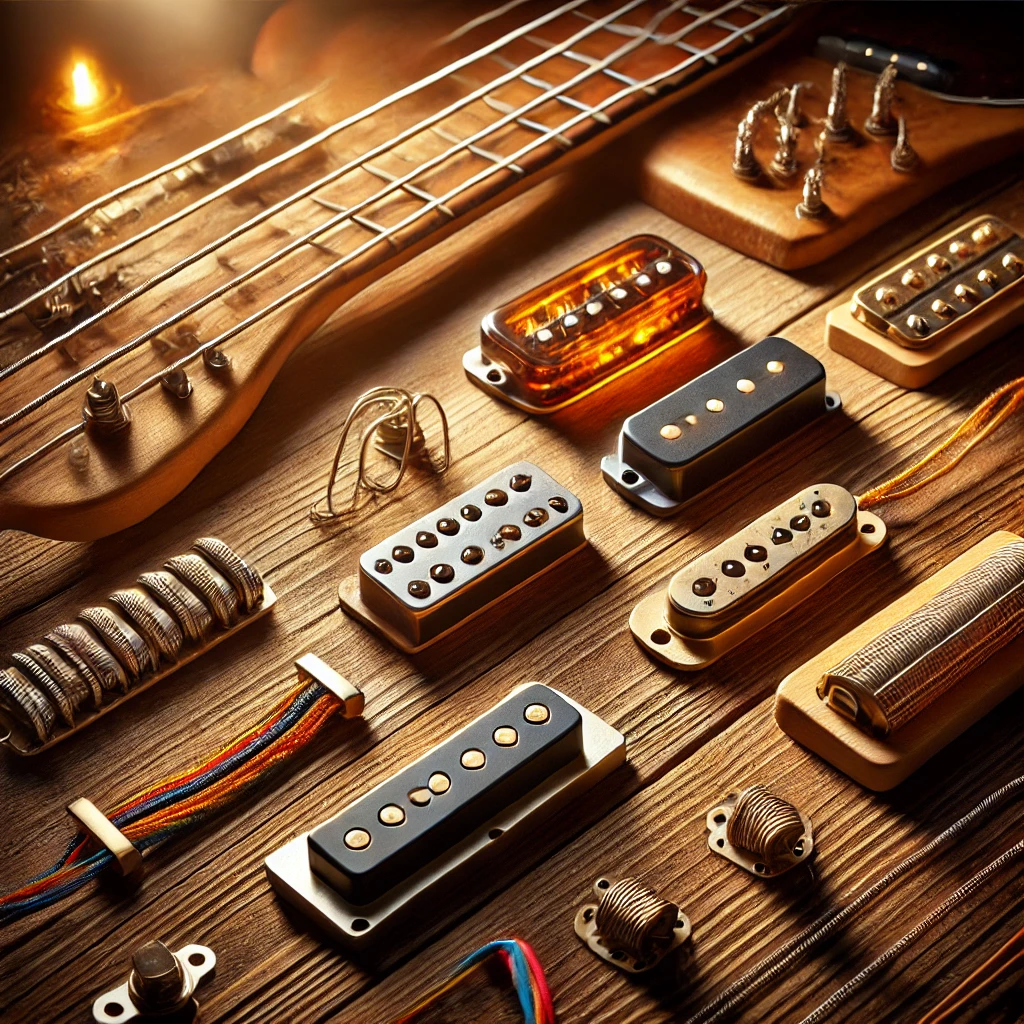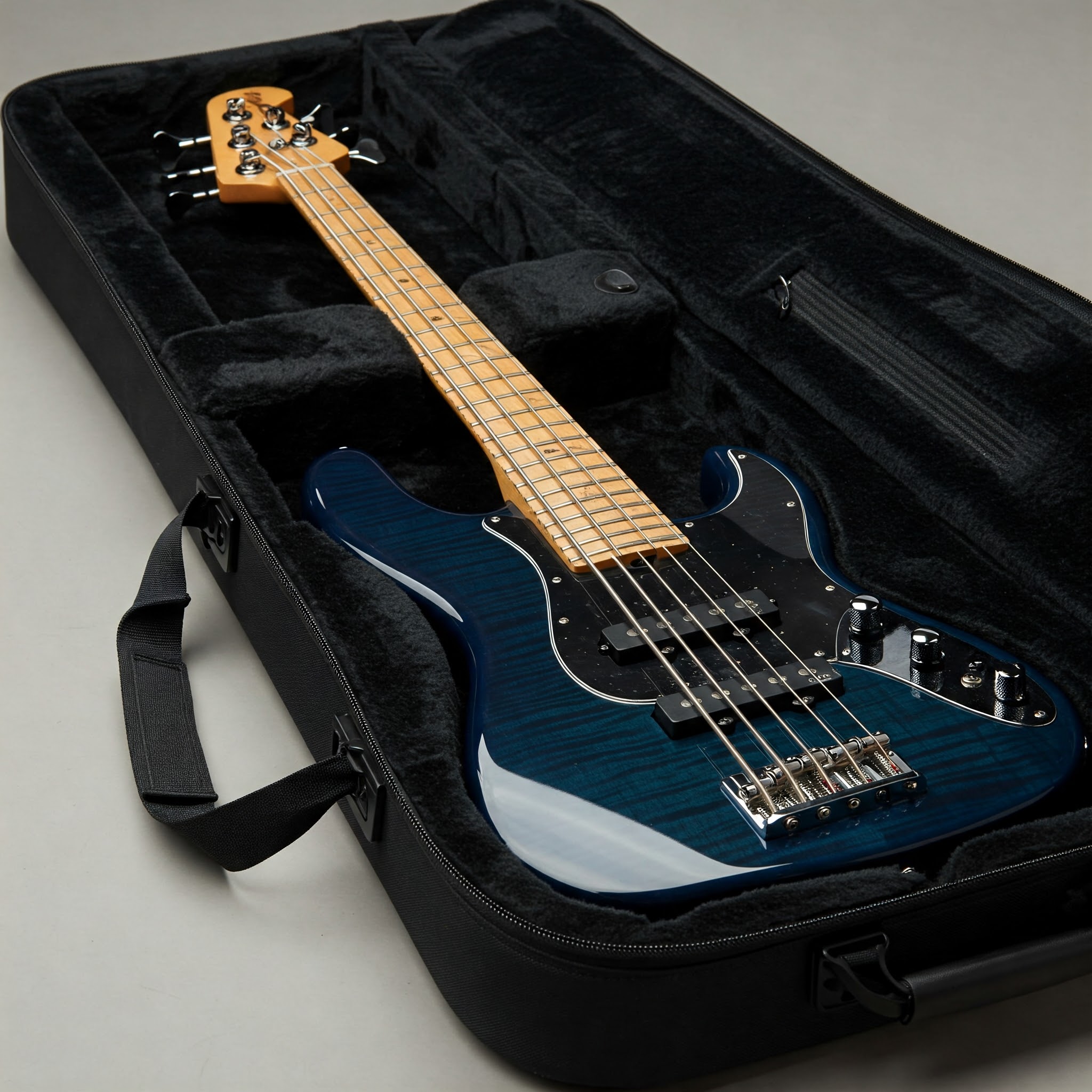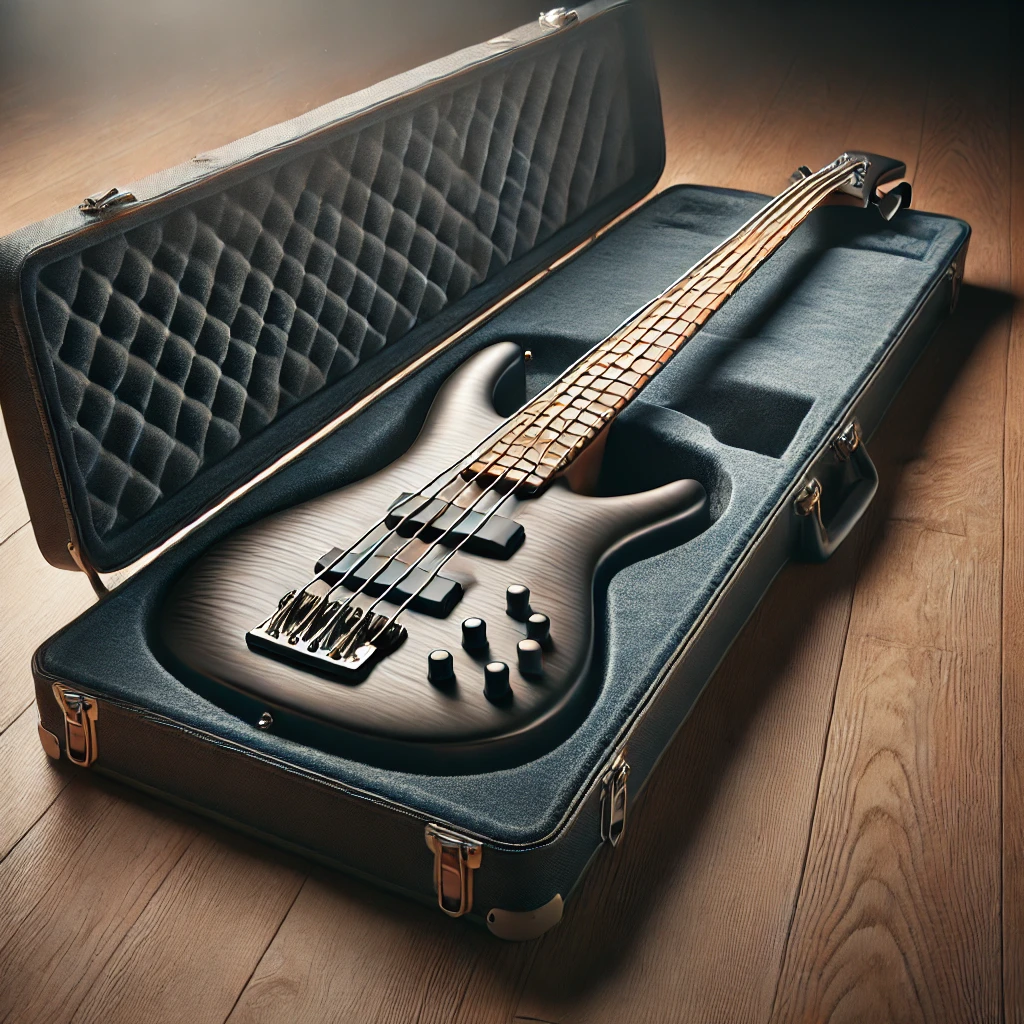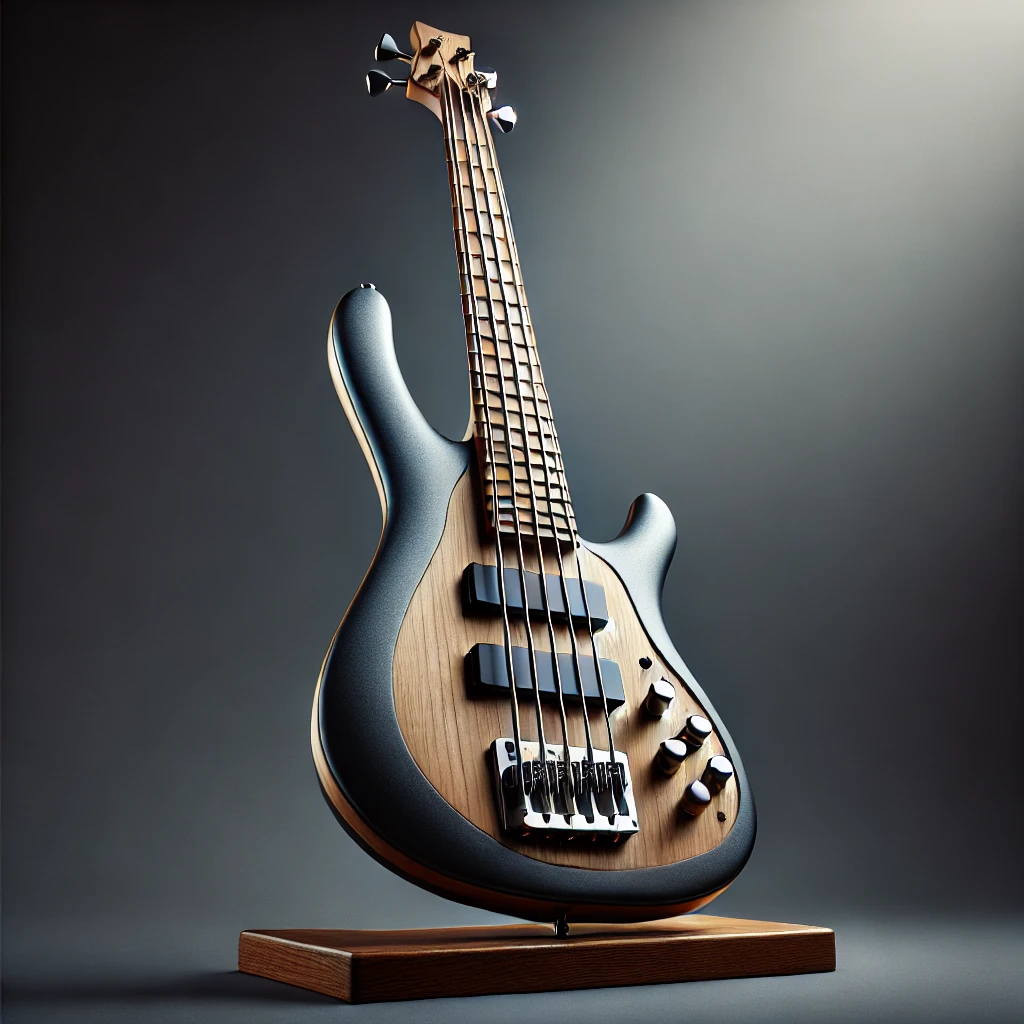🎸 Introduction: Finding Your Perfect Bass Voice
Have you ever picked up your bass guitar, played a few notes, and thought, “Something’s missing here”? That elusive, perfect tone seems just out of reach, no matter how much you adjust your amp or tweak your playing technique. Well, I’ve got news for you—the secret might be hiding right under your fingertips, in the form of your bass pickups.
As a bassist for over 15 years, I’ve learned that bass pickups are the unsung heroes of great bass tone. They’re the magical little devices that capture your string vibrations and transform them into electrical signals, ultimately defining what comes out of your speakers. Choosing the right bass pickups isn’t just about making your instrument louder—it’s about finding your unique voice in the music.
In this comprehensive guide, we’ll dive deep into the world of bass pick-ups, exploring everything from the fundamental differences between pickup types to expert installation tips. Whether you’re a seasoned pro looking to fine-tune your sound or a beginner wondering why your budget bass doesn’t sound like the recordings, this guide will help you understand, choose, and optimize your bass pickups for that perfect tone.
🔍 Understanding Bass Pickups: The Heart of Your Sound
What Are Bass Pickups and How Do They Work? ⚡
At their core, bass pickups are relatively simple devices with an incredibly important job. They consist of magnets wrapped with thousands of turns of copper wire, creating a magnetic field around your strings. When you pluck a string, it vibrates within this magnetic field, disturbing it and generating a tiny electrical current. This current is what gets amplified and eventually emerges as your bass sound.
The magic of bass pickups lies in how they capture these vibrations. Different pickup designs emphasize various frequencies and harmonics, giving each type its distinctive character. It’s why a P-bass sounds different from a Jazz bass, and why changing your bass pick-ups can completely transform your instrument’s voice.
The Critical Impact of Pickup Placement 📏
Where your bass pickups sit on the body significantly affects your tone. Pickups positioned near the neck capture warmer, rounder tones with more fundamental frequencies and fewer harmonics. In contrast, bass pickups placed closer to the bridge pick up brighter, more articulate sounds with enhanced treble response.
This is why many basses feature multiple bass pickups in different positions—it gives players access to a broader palette of tones. By blending these pickup outputs in various combinations, you can sculpt your sound to fit any musical situation.

🔄 Types of Bass Pickups: Finding Your Tonal Match
Passive vs. Active Bass Pickups: The Great Debate 🔋
Passive Bass Pickups: The Classic Approach
Passive bass pick-ups have been around since the dawn of electric bass and offer a warm, organic tone that many players swear by. They work without any additional power source, delivering your string vibrations directly to the amp with minimal coloration.
✅ Advantages of Passive Bass Pickups:
- Warm, vintage tone with natural dynamics
- No batteries required (ever run out mid-gig? Not fun!)
- Typically simpler controls and fewer things to go wrong
- Often more affordable than active systems
❌ Limitations of Passive Bass Pickups:
- Less output level than active pickups
- Limited onboard tone shaping
- More susceptible to noise and interference
- Tone affected by cable length and quality
Active Bass Pickups: Modern Power and Precision
Active bass pickups incorporate a preamp powered by a battery, boosting the signal and allowing for more tone-shaping options right on your instrument. They revolutionized bass playing in the 1970s and remain popular for many styles.
✅ Advantages of Active Bass Pickups:
- Higher output for stronger signal
- Onboard EQ for precise tone control
- Lower noise and cleaner signal
- Less affected by cable quality or length
❌ Limitations of Active Bass Pickups:
- Require batteries (typically 9V)
- Some players find them less “organic” sounding
- Generally more expensive
- More complex electronics can fail
My Personal Experience: After years of being a passive pickup purist, I reluctantly tried active bass pick-ups on a new instrument and was blown away by the clarity and punch they provided for modern styles. However, I still reach for my passive-equipped bass when playing more traditional genres. It’s not about which is better—it’s about which fits your musical voice.
Single-Coil vs. Humbucker Bass Pickups: Clarity or Power? 🎛️
Single-Coil Bass Pickups
Single-coil bass pickups use one coil of wire wrapped around magnets. They’re known for their bright, clear tone with pronounced high-end detail.
✅ Advantages of Single-Coil Bass Pickups:
- Articulate, clear sound
- Excellent note definition
- Classic “Jazz Bass” tone
- Great for slap, fingerstyle, and pick playing
❌ Limitations of Single-Coil Bass Pickups:
- Susceptible to hum and interference
- Typically less output than humbuckers
- Can sound thin in some contexts
Humbucker Bass Pickups
Humbucker bass pickups use two coils wired together in opposite directions, which cancels out unwanted noise while providing a fuller sound.
✅ Advantages of Humbucker Bass Pick-ups:
- Reduced noise and hum
- Thicker, more powerful tone
- Greater output level
- Excellent for rock, metal, and high-gain settings
❌ Limitations of Humbucker Bass Pickups:
- Can sacrifice some clarity and high-end detail
- Might be too “dark” for some styles
- Less “snap” for techniques like slapping
Split-Coil vs. Soapbar vs. MM-Style: Classic Designs Explained 🛠️
Split-Coil (P-Style) Bass Pickups
The iconic Precision Bass pickup design uses two halves of a single pickup, with each half capturing different sets of strings. This creates a full, balanced tone that sits perfectly in almost any mix.
The Fender Original Precision Bass Pickup delivers that classic P-bass thump that has driven countless hit records. This authentic replacement pickup offers the warm, punchy tone that made the P-bass famous.
Soapbar (J-Style) Bass Pickups
Named for their rectangular shape, soapbar bass pick-ups are versatile single-coil designs that can be found in many configurations. The classic Jazz Bass uses two soapbar pickups of different widths.
For authentic J-bass tone, the Seymour Duncan Quarter Pound Jazz Bass Pick-up Set offers enhanced output while maintaining that classic Jazz Bass growl and articulation.
MM-Style Bass Pickups
Based on the design pioneered by Music Man in the 1970s, MM-style bass pickups use large pole pieces and powerful magnets for a punchy, aggressive sound with excellent articulation.
The EMG MMTW Active Dual Mode MM-Style Bass Pickup gives you the ability to switch between massive MM punch and single-coil clarity with the push of a button.
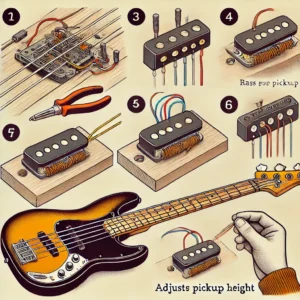
📊 Bass Pickup Comparison Table
| Pickup Type | Tone Characteristics | Best For | Noise Level | Output Level | Price Range |
|---|---|---|---|---|---|
| Passive P-Style | Warm, fat, punchy | Rock, blues, classic styles | Moderate | Moderate | $60-150 |
| Passive J-Style | Bright, growly, articulate | Funk, R&B, versatile | Higher | Moderate | $70-180 |
| Active Humbuckers | Powerful, defined, balanced | Metal, fusion, modern styles | Low | High | $100-250 |
| Active Soapbars | Clean, hi-fi, versatile | Studio, progressive, versatile | Low | Very High | $120-300 |
| MM-Style | Aggressive, punchy, clear | Slap, rock, anything loud | Low | High | $90-200 |
Ready to upgrade your sound? Check out our top picks for bass pickups that will transform your playing experience. Click recommeded links to see current prices and deals on Amazon
🔧 Installing Bass Pickups: DIY or Professional Job?
Tools You’ll Need for a DIY Installation ⚒️
If you’re comfortable with basic soldering and electronics, installing new bass pickups can be a rewarding DIY project. Here’s what you’ll need:
- Soldering iron and solder
- Wire cutters/strippers
- Screwdrivers (Phillips and flathead)
- Pliers
- Masking tape and marker (for labeling wires)
- Multimeter (optional but helpful)
- Patience (not optional!)
Step-by-Step Installation Guide 📝
- Document your current setup: Take clear photos of your existing wiring before disconnecting anything.
- Remove strings: Completely remove your strings to access the pickups.
- Remove control plate/pickguard: Carefully unscrew and lift to expose the electronics.
- Label all wires: Mark each wire’s connection point before desoldering.
- Remove old pickups: Desolder connections and unscrew pickups from the body.
- Install new pickups: Mount the new bass pick-ups in position.
- Wire according to diagram: Follow the wiring diagram that came with your new pickups.
- Test before reassembly: If possible, temporarily connect to your amp to check functionality.
- Reassemble and restring: Put everything back together and install fresh strings.
- Fine-tune pickup height: Adjust how close the bass pick-ups sit to the strings for optimal sound.
When to Seek Professional Help 🚑
While many bassists successfully install their own bass pick-ups, there are times when a professional setup is worth the investment:
- If your bass has complex electronics or active systems
- When installing significantly different pickup types requiring new routing
- If you’re working with a valuable vintage instrument
- When you lack confidence in your soldering skills
For those ready to dive into DIY installation, the StewMac Bass Wiring Kit includes all the premium components you need to wire your new pickups like a pro.
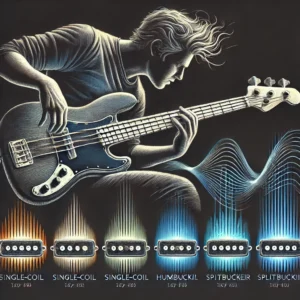
🎯 Choosing the Right Bass Pickups for Your Style
For Rock and Metal Bassists: Power and Punch 🤘
Rock and metal require bass pickups that can deliver power, punch, and clarity to cut through distorted guitars. Active humbuckers excel here, providing the output and midrange definition needed for these genres.
The EMG GZR-P Bass Pickup Set was designed with metal legend Geezer Butler and delivers the aggressive punch needed for heavy styles while maintaining excellent definition.
For Jazz and Blues Players: Warmth and Dynamics 🎷
Jazz and blues benefit from bass pickups that can capture subtle dynamics and provide the warm, woody tone these genres traditionally favor. Passive pickups, particularly vintage-style designs, often excel here.
The Nordstrand Big Split Bass Pickup Set offers incredible vintage warmth with enhanced clarity, perfect for jazz, blues, and acoustic-leaning styles.
For Funk and Slap Techniques: Attack and Brightness ⚡
Funk and slap playing demand bass pickups that emphasize attack transients and provide the snap and pop that these techniques require. Bright single-coils or MM-style pickups typically work best.
For authentic slap tone, the Bartolini MM4CBC-T Original MM Bass Pickup provides the perfect balance of punchy attack and musical warmth.
For Studio Recording: Versatility and Clarity 🎚️
In the studio, versatility is king. Bass pickups with multiple tone options or blendable pickup configurations allow you to dial in the perfect sound for each track without switching instruments.
The Aguilar AG 4J-HC Jazz Bass Pickup Set offers studio-grade clarity and response, with a hum-canceling design that’s perfect for recording environments.
🔝 Top Bass Pickup Recommendations for 2025
Best Overall Bass Pickups
The Seymour Duncan Quarter Pound P/J Bass Pickup Set combines the best of both worlds with a powerful P-style pickup in the neck position and a growling J-style pickup at the bridge. This set offers incredible versatility and tone at a reasonable price point.
Best Budget Bass Pickups
For bassists on a budget, the Fender Gen 4 Noiseless Jazz Bass Pickups deliver noise-free performance with authentic vintage tone at a price that won’t break the bank.
Best Premium Bass Pickups
If price is no object, the Nordstrand Big J-Blade Bass Pickup Set represents the pinnacle of bass pickup technology, with hand-wound coils and premium materials that deliver unmatched tone and response.
Best for Vintage Tone Seekers
The Lindy Fralin Split Coil Bass Pickup is meticulously crafted to capture the magic of early 60s P-bass tone, with incredible attention to detail and authentic materials.
Best for Modern Metal and Prog
Metal and progressive players will love the EMG 45DC Active Bass Pickup, which delivers massive output, incredible sustain, and precise attack for technical playing styles.

📈 Detailed Product Comparison Table
| Pickup Model | Type | Best For | Output | EQ Profile | Noise | Price |
|---|---|---|---|---|---|---|
| Seymour Duncan Quarter Pound P/J | Passive P/J Set | All-around versatility | High | Full mids, balanced | Low | $$$ |
| EMG GZR-P | Active P/J Set | Rock, metal, modern | Very High | Scooped mids, tight bass | Very Low | $$$$ |
| Fender Gen 4 Noiseless Jazz | Passive J | Traditional with modern clarity | Medium | Classic J sound, bright | Very Low | $$ |
| Nordstrand Big Split | Passive P | Jazz, blues, acoustic | Medium | Warm, natural, woody | Moderate | $$$$ |
| Bartolini MM4CBC-T | MM-Style | Slap, funk, rock | High | Punchy midrange, tight | Low | $$$ |
Transform your bass sound today with these incredible pickup options! Click recommeded links to see current pricing and availability on Amazon
❓ Frequently Asked Questions About Bass Pickups
How much difference do bass pickups really make? 🤔
The difference between stock bass pickups and high-quality replacements can be dramatic. While your playing technique and amp settings certainly matter, bass pick-ups are the first step in your signal chain and significantly impact every aspect of your tone. Many bassists are shocked by how different their instrument sounds after a pickup upgrade—it can feel like getting a completely new bass!
Will changing my bass pickups affect my playing style? 🎯
Absolutely. Better bass pick-ups often inspire new playing techniques by bringing out nuances you couldn’t hear before. When you can clearly hear subtle ghost notes or harmonic content that was previously buried, you’ll naturally adjust your playing to take advantage of this enhanced clarity. Many bassists find they play differently—and often better—after upgrading their bass pickups.
Do expensive bass pickups sound better than cheaper ones? 💰
Not necessarily. While premium bass pickups often use higher-quality materials and more precise manufacturing techniques, “better” is subjective when it comes to tone. Some legendary bass sounds were created with relatively inexpensive instruments and pickups. The key is finding bass pick-ups that complement your instrument and playing style, regardless of price point.
Can I mix different types of bass pickups? 🔄
Yes, mixing different bass pickups is a common practice that can yield unique tones. The classic P/J configuration (Precision pickup in the neck position, Jazz pickup at the bridge) is just one example of how combining different pickup types can offer greater tonal versatility. Just ensure the output levels are reasonably balanced, or you may find one pickup dominating the blend.
How often should I replace my bass pickups? ⏰
Unlike strings, bass pickups don’t wear out quickly. Quality pickups can last decades without degradation. The main reasons to replace them are if they’re physically damaged, producing unwanted noise, or simply if you’re seeking a different tone. Many professional bassists change bass pick-ups to suit different recording projects or musical directions rather than due to wear and tear.
🔍 Understanding Bass Pickup Specifications
Impedance: What It Means for Your Tone 🧲
Impedance (measured in ohms) describes your bass pickups’ electrical resistance. Higher impedance pickups typically have more winds of wire and produce a warmer, vintage-style tone with reduced high frequencies. Lower impedance designs offer more treble response and often pair better with active electronics.
Output Level: Finding the Right Balance ⚖️
Output level refers to the strength of the signal your bass pick-ups generate. Higher output pickups hit your amp harder, which can be great for driving tube amps into natural compression or getting more sustain. However, ultra-high output pickups can sometimes lack the dynamic range of moderate output designs, making subtle playing techniques less expressive.
EQ Curve: The Tonal Fingerprint 📊
Every set of bass pickups has a unique frequency response or “EQ curve.” Some emphasize low mids for a fat, punchy sound, while others boost high frequencies for more clarity and articulation. Understanding a pickup’s natural EQ tendencies helps you choose one that either complements or counterbalances your bass’s inherent tone.
🧠 Advanced Tips for Bass Pickup Optimization
Fine-Tuning Pickup Height for Optimal Tone 📏
The distance between your bass pickups and strings dramatically affects your tone. Closer positioning increases output and emphasis on fundamental frequencies but can reduce dynamics. Setting the pickups lower decreases output but often improves clarity and string-to-string balance. Experiment with different heights—even 1mm changes can significantly alter your sound.
Pro tip: Many professionals set their bass pick-ups slightly lower on the bass string side and higher on the treble side to balance output across all strings.
Coil Tapping/Splitting: Two Sounds in One 🔀
Some humbucker bass pick-ups offer coil-tapping or coil-splitting options, allowing you to access single-coil tones from a humbucker pickup. This feature essentially gives you two different pickup sounds from a single installation—ideal for players who need versatility without changing instruments.
The DiMarzio Model P DP122 Bass Pickup features coil-splitting capability, giving you both fat humbucker tones and focused single-coil sounds at the flip of a switch.
Shielding: Eliminating Unwanted Noise 🛡️
Even the best bass pickups can benefit from proper cavity shielding. Lining your instrument’s control cavities with copper tape or conductive paint creates a Faraday cage that blocks external electromagnetic interference. This upgrade is particularly valuable for single-coil pickup users or those who play under stage lighting or near digital equipment.
For easy shielding, the StewMac Conductive Copper Tape Kit provides everything you need to professionally shield your pickup cavities and dramatically reduce unwanted noise.
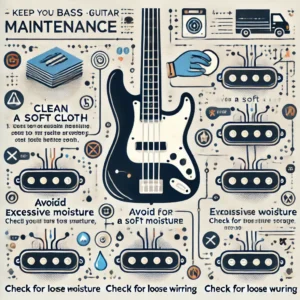
🏁 Conclusion: Finding Your Personal Bass Voice
Your choice of bass pickups represents one of the most significant tone-shaping decisions you can make as a bassist. While there’s endless debate about which pickups are “best,” the truth is that the perfect bass pickups for you are the ones that inspire your playing and help you express your musical ideas.
Whether you prefer the warm thump of vintage-style passives, the aggressive punch of modern actives, or something in between, the right bass pickups should feel like an extension of your musical personality. Don’t be afraid to experiment—sometimes unexpected choices lead to your signature sound.
Remember that bass pickups are just one part of your tonal equation. They work in concert with your instrument’s construction, your playing technique, your strings, and your amplification. The most satisfying bass tone comes from thoughtfully matching all these elements to support your musical vision.
Ready to elevate your bass tone to new heights? The perfect pickups are just a click away. Explore our top recommendations now and transform your sound today!
More FQAs:
❓ What are the different types of bass pickups?
✅ The main types of bass pickups are single-coil, split-coil, humbucker, and piezo. Each offers distinct tonal characteristics, from bright and punchy to warm and deep...
❓ How do active and passive bass pickups differ?
✅ Passive pickups provide a warm, natural tone with dynamic response, while active pickups use a preamp for higher output, extended clarity, and onboard EQ control...
❓ Which bass pickup is best for slap bass?
✅ Jazz-style single-coil pickups and certain active pickups are preferred for slap bass due to their bright, articulate response and enhanced midrange presence...
❓ Can I mix different types of bass pickups?
✅ Yes, many bassists mix pickups, such as a split-coil in the neck and a single-coil in the bridge, to achieve a more versatile tone with both warmth and clarity...
❓ How do I know when to replace my bass pickups?
✅ If your bass tone lacks clarity, has weak output, or produces unwanted noise despite proper shielding, it may be time to upgrade or replace the pickups...
Recommended for You:
- Unleash Your Musical Potential with the Exceptional Squier Jazz Bass: A Complete Guide 2025
- Discover the Perfect Bass Guitar with Case: Ultimate Guide to Protect Your Investment 2025
- The Ultimate Guide to 4 String Electric Bass: Top Picks & Expert Tips for 2025
Disclaimer: This article contains affiliate links. If you purchase products through these links, we may earn a small commission at no additional cost to you.
